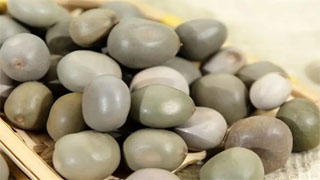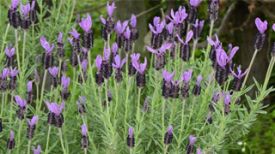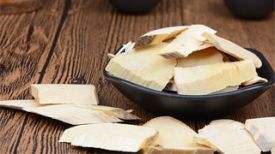
Nicknames: Yuanshi, Tiandou, Madou, Chaotianzi
Harvesting and processing: Harvesting in autumn when the fruit is ripe, peeling off the seeds, and drying in the sun.
Medicinal parts: seeds
Origin: East China, Central South, Southwest China, Hebei, Shaanxi, Gansu
Family: Leguminosae
Original plant: Yunshi
Plant condition: Climbing shrubs
The bark is dark red and densely covered with barbs.
The leaves are broad, half arrowhead shaped, and fall early; Bipinnate compound leaves, 20-30cm long, with 3-10 pairs of leaflets, opposite, peduncle, and 1 pair of spines at the base. Each leaflet has 7-15 pairs of leaflets, membranous, oblong, 10-25mm long, 6-10mm wide, rounded apex, slightly lobed, base blunt, both sides covered in short hairs, sometimes shedding hairs.
The inflorescence is terminal and 15-30cm long; The total flower stem is prickly; The flower is symmetrical on both sides, with a stem length of 2-4cm, strong and straight, and a joint under the calyx. The flower is easy to fall off; Sepals 5, oblong, covered with short hairs; Petals 5, yellow, rolled back when in full bloom; Stamen 10, separated, densely hairy below the middle of the filament; The ovary is superior and hairless.
The pod is nearly woody, short tongue shaped, skewed, 6-12cm long and 2-3cm wide, slightly swollen, with a pointed beak at the tip, expanding into narrow wings along the ventral suture, cracking along the ventral suture when mature, hairless, chestnut brown, glossy; 6-9 seeds, oblong in shape, brown in color. The flowering and fruiting period is from April to October.
Characteristics of Yunshi medicinal herbs: The seeds are oblong in shape, approximately 1cm in length and 6mm in width. The outer skin is brown black, with vertical gray yellow texture and horizontal crack like rings. The seed coat is hard, and after peeling off, there are 2 brownish yellow cotyledons inside. Mild odor, bitter taste.
Yunshi Medicinal Properties:
[Original text of this sutra] It has a pungent and warm taste, is mainly used for promoting diuresis, intestinal digestion, killing insects and toxins, eliminating evil qi, relieving pain and heat, and has a strong sense of ghosts and spirits. Eating too much can make people go crazy. Long term consumption can light the body and invigorate the gods. 【 Origin 】 It can be found everywhere.
[Taste] It has a spicy and slightly bitter taste, and a warm nature.
【 Indications 】 Yunshi is an essential medicine for stopping diarrhea, malaria, and insecticides.
Su Song: Used for treating malaria.
[Dosage] Normally one to three yuan.
[Taboo] Taboo for those who benefit from cold. "
[Taste] Spicy; Suffering; temperature
[Guijing] Lung; Large intestine meridian
【 Functions and Indications 】 Detoxification and dehumidification, cough and phlegm reduction, insecticide. Main dysentery, malaria, chronic tracheitis, infantile chancre, and worm accumulation
[Usage and Dosage] Oral administration: decoction, 9-15g; Or into pills or powder.
【 Discussions from Various Schools 】 1. The "Ben Jing": It is mainly used to relieve diarrhea and intestinal congestion, eliminate evil qi, relieve pain, and eliminate cold and heat.
2. "Bielu": The main function is to quench thirst.
3. "Compendium of Materia Medica": It is commonly used in the treatment of malaria.
4. The Compendium of Materia Medica: It deals with pus and blood in the lower body.
5. List of Medicinal Resources in Wenling County: Insecticidal and Damp Heat Removal. Treating infantile chancre and incomplete measles: Women's breast abscess. "


